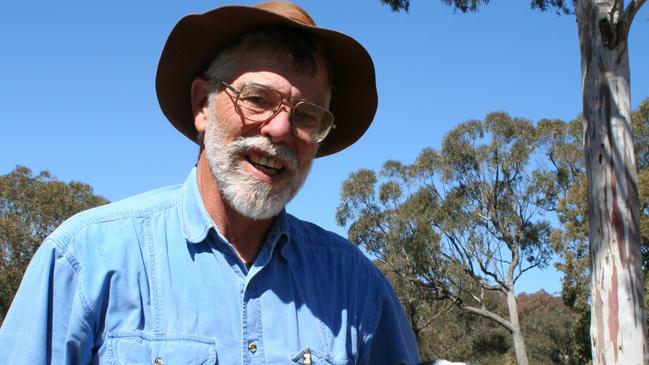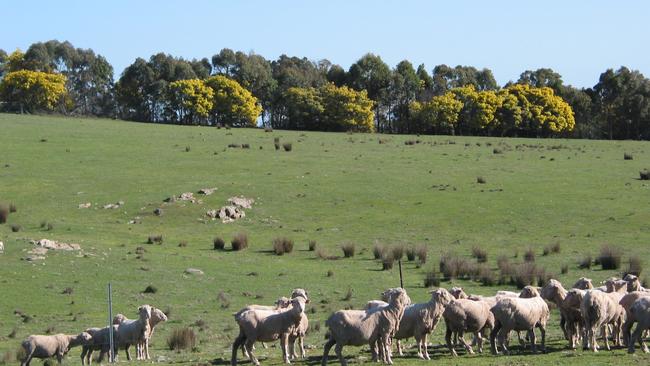Talking dirty: why the soil carbon debate hasn’t been settled
It’s a methodology which is yet to be fully embraced by even ardent proponents of climate action so can carbon capture be a win-win for farmers and industry?

John Ive owns some of the most challenging soils in Australia but over more than 40 years of TLC, he’s captured extraordinary amounts of carbon – the new cash crop for the nation’s farmers.
Since 1980, Ive’s property near Yass has sequestered 11 times more carbon in trees and soil than the emissions from livestock and farm operations. But the producer of ultrafine merino wool is not about to sign up to the carbon market created to help save the planet – and provide a new income stream for farmers.
“What happens in 30 years’ time with climate change predictions of higher temperatures and lower effective rainfall?” Ive asks.
“Under harsh conditions you will lose soil carbon, even with best practice. I won’t enter into a contract with the risk that future soil carbon will be less than what I have now, despite my best efforts.”
The 79 year old with degrees in agricultural science and economics worked as an agronomist in the Northern Territory before buying a farm with soils so degraded it was regarded as a “basket case”.
Ive and his wife Robyn named it Talaheni, Arabic for “wait a while”, and launched a decades-long improvement plan.
“To be perfectly honest, I never set out just to increase soil carbon per se,” he says.
“When we took it on, soil carbon levels were 0.7 per cent. They are now around 3.2 per cent, which is close to the highest level we can expect for our soil types and rainfall.”
Ive is not alone in deciding that while capturing carbon is good for his grass and the planet, selling credits to industry to offset its emissions may not be the El Dorado some suggest. He’s not alone among farmers wondering what happens if the climate they are trying to fix hits back, carbon drops and they can’t deliver on contracts that run for 25 or 100 years.
Carbon credits, the great majority in vegetation projects, have yielded farmers hundreds of millions of dollars since the Gillard government introduced legislation in 2011, but 13 years on, scientists, farming bodies, carbon brokers and public servants wrestle with the risks versus rewards. And as some early projects that involved retaining or planting trees lose traction following intense criticism, some are asking whether soil carbon will fill the gap.

Carbon capture in agricultural land might once have seemed liked flying pigs, but a raft of legislation and regulation and a whole new industry of advisers and service providers developed over the past decade have made it much more credible. At the centre, in this country, is a single instrument – the Australian Carbon Credit Unit issued to landholders for every tonne of carbon captured – which is then used to offset emissions from agriculture or from big fossil-fuel industries.
Does it all work? Are credits a rural fantasy, a realistic tool to help Australia get to net zero by 2050, or just a nice little earner for farmers and advisers? Do ACCUs get governments off the hook and simply appease voters pushing companies to go green, or do they really offset industrial emissions?
At first, sequestering carbon in trees and vegetation looked like a win-win as farmers agreed to stop clearing trees and to abandon grazing in return for an income. Some had never seen such cash. But in 2022, as some scientists argued that improved carbon was due to climate rather than the management method known as Human Induced Regeneration (HIR), the Albanese government appointed Professor Ian Chubb to review the scheme. In February last year the government dumped HIR; there would be no new projects although existing projects could still get credits.
The decision was a blow to brokers, farmers and a government with a vested interest in creating a supply of reasonably priced credits for industry to buy as offsets.
Amid the uncertainty over HIR, soil emerged as a potential solution, with a rise in projects: there are now more than 500 soil carbon projects, about 25 per cent of the 2074 projects registered with the Clean Energy Regulator since the scheme began in 2012.
Any credits earned are either held by the landholder or sold to the government or directly to companies as offsets. Since the scheme began, more than 141 million ACCUs have been issued but only 253,199 have been for soil carbon. While some researchers argue that we will need to store carbon for centuries to truly offset fossil fuel emissions, soil sequestration is having a moment.
Soil scientists like Professor Peter Grace of the Queensland University of Technology are delighted at the increased attention to an area he has researched for more than 30 years. “It’s sort of opened up the debate more about soil conservation, it’s put soils back on the agenda and it’s great,” he says. Grace reviewed the latest regulations, known as the method, for growing soil credits before they were released in 2021 and found the scheme “rigorous enough”. Since then, he says, the government has been very receptive to feedback to make the scheme more robust.
He’s not a big fan of selling credits: “I think the farmers should keep the credits because they will have to do an account of their products in the future. Look at what’s happening in Europe, you can’t sell a crop into Europe without having a low carbon. If you sell your carbon credits now, you’re buggered.” But whether to cash in your carbon is a separate issue from whether the ACCU scheme offers true amelioration. Peter Grace is clear on that one. “It’s definitely not a fraud,” he says.
Difficult calculations
The regulations around ACCUs are daunting in their detail. Compliance and the cost of hiring agronomists to set baselines levels of carbon in your land and then collect results have led many farmers to sign with expert service providers who carry the initial costs of a project in return for a cut, sometimes as high as 30 to 50 per cent, of the ACCUs.
That makes sense to busy farmers but worries bodies like the National Farmers Federation, which sees ACCUs as a big opportunity but wants government to provide farmers with independent advice about the risks of entering contracts that can run for either 25 or 100 years.

There are concerns too that carbon cropping means land will be locked out of agriculture.
That’s another reason soil projects get a big wrap: unlike the tree and vegetation projects, farmers who register their soil must continue farming. Indeed, they must add new practices such as better fertiliser application, re-establishing pasture, or modifying grazing practices. Landholders register a project for either a 25 year or a 100 year “permanence period” during which carbon levels must be maintained. That means the new farm practices have to continue even if the land is sold. One challenge is that soil becomes saturated with carbon, usually over a cycle of 20 to 40 years, depending on soil quality. After that, as farmer John Ive, suggests, it may be difficult to maintain it in the future. Peak sequestration is fine if you just want healthy soil but it’s a risk for farmers locked into long-term contracts.
The NFF, like other players, is waiting for the government’s next move, expected later this year – an integrated farm and land management plan, designed as a “whole of property” carbon farming method. It is expected to allow soil projects to run adjacent to revegetation projects, which means farmers won’t have to choose one over the other; and it is likely to refashion the approach to the HIR projects dumped after the Chubb report.
For now the buzz is around soil with plenty to debate: there’s no argument you can increase carbon in the soil; the issue is how to hold on to it and measure it. Scientists like Peter Grace warn soil carbon fluctuates in response to climate. “There are cycles when you get an increase in carbon in response to favourable weather over a number of years, but when it dries out, that carbon is lost,” he says. “Soil carbon sequestration has been known for decades, for centuries. We’ve looked at long-term experiments, we know it does change, and it changes in response to management, it’s all well proven, but we need to look carefully at rewarding credits in a potentially transient system.”
Then there’s measurement. A project must sample for credits within one to five years of setting the baseline and then at least every five years. It means you can get credits after only one year, although a discount applies. Grace worries that’s too soon and wants a minimum of three years, or better still five years, because “changing carbon is quite slow”.
There’s also debate about how deep to go in measuring carbon. The internationally accepted standard and the minimum level in Australia is 30cm but there’s no maximum and samples taken at up to about a metre are accepted as part of the ACCU assessment. Some scientists dismiss the deep sampling, arguing that it’s meaningless; the carbon is more stable, which is good, but whether more can be captured and stored at depth depends on whether you can get it down there and whether there are mineral surfaces where it can be held in protected forms.
Bill Hurditch, an ecologist and consultant who is a research adviser on deep measurement for the Macdoch Ag Group, says carbon at depth can be increased by rotational grazing as animals stir up the soil to encourage plant growth.
He’s optimistic, even as some scientists warn that building soil carbon in arid and semi-arid grazing land is a big challenge because you need plenty of rain. Hurditch says: “Let’s assume there are about 400 million hectares of land in Australia that is used for some form of grazing. If we took the best 10 per cent of the land and sequestered carbon at a rate of 0.6 tonnes of soil organic carbon per hectare per year, we could draw down a significant amount of CO2 every year.” In fact, he calculates that 40 million hectares could gain up to 100 million tonnes of CO2 each year: that’s about 20 per cent of Australia’s total emissions and much more than the 16 per cent blamed on agriculture.
Hurditch says we have 20 to 30 years to get a significant carbon drawdown and offsets are the way to do it: “I don’t think it’s the long-term answer; the long-term answer is to bring overall emissions down. Draw down is very much a stopgap measure while other emitters are dealing with their problems. It’s very much an interim measure.”
Compromise
Macdoch is involved in a number of ventures and is part of Alasdair MacLeod’s Macdoch Group, which also owns service provider Atlas Carbon. In 2021 MacLeod was involved in the sale of two soil carbon credit packages, each worth $500,000, to Microsoft to use as offsets. One involved credits from his father-in-law Rupert Murdoch’s property, Cavan, near Yass; the other used credits from MacLeod’s Wilmot Station on the New England Tablelands. The credits were not ACCUs but were awarded by a US-based voluntary carbon registry run by Regen Network. They used measurements taken at about 30cm. (Rupert Murdoch is chairman emeritus of News Corp, which publishes this newspaper.)
MacLeod says he used Regen Network because it allowed immediate measurement. “We thought it important for the whole sector that we could demonstrate the sorts of results that were going to be possible with well-managed grazing operations,” he says.
He strongly supports the Australian scheme and has registered two other properties with the domestic regulator, applauding its “far superior methodology, even though more time-consuming and expensive” and because it measures carbon levels down to below one metre “where they are more stable”. He too sees the ACCUs as a “Band-Aid” while other technologies are developed to reduce industry emissions, and believes farmers should first use the credits to offset agricultural emissions, with surplus offsets used in other sectors.
Industry needs to reduce emissions directly, he says, but “until the technology is available to decarbonise, for example, flying aeroplanes, or making cement or steel, we are going to have to rely on offsets.”
Meanwhile, Macintosh argues there is so much natural variability in soil carbon that “the majority of what people have been credited for is likely to be rainfall-induced” and suggests the government identify the best methods for carbon reduction and subsidised farmers who adopt them. He doesn’t see an end to ACCUs, arguing there’s such a “ferocious offset lobby, just as ferocious as the fossil fuel lobby” that carbon credits are here to stay.




To join the conversation, please log in. Don't have an account? Register
Join the conversation, you are commenting as Logout